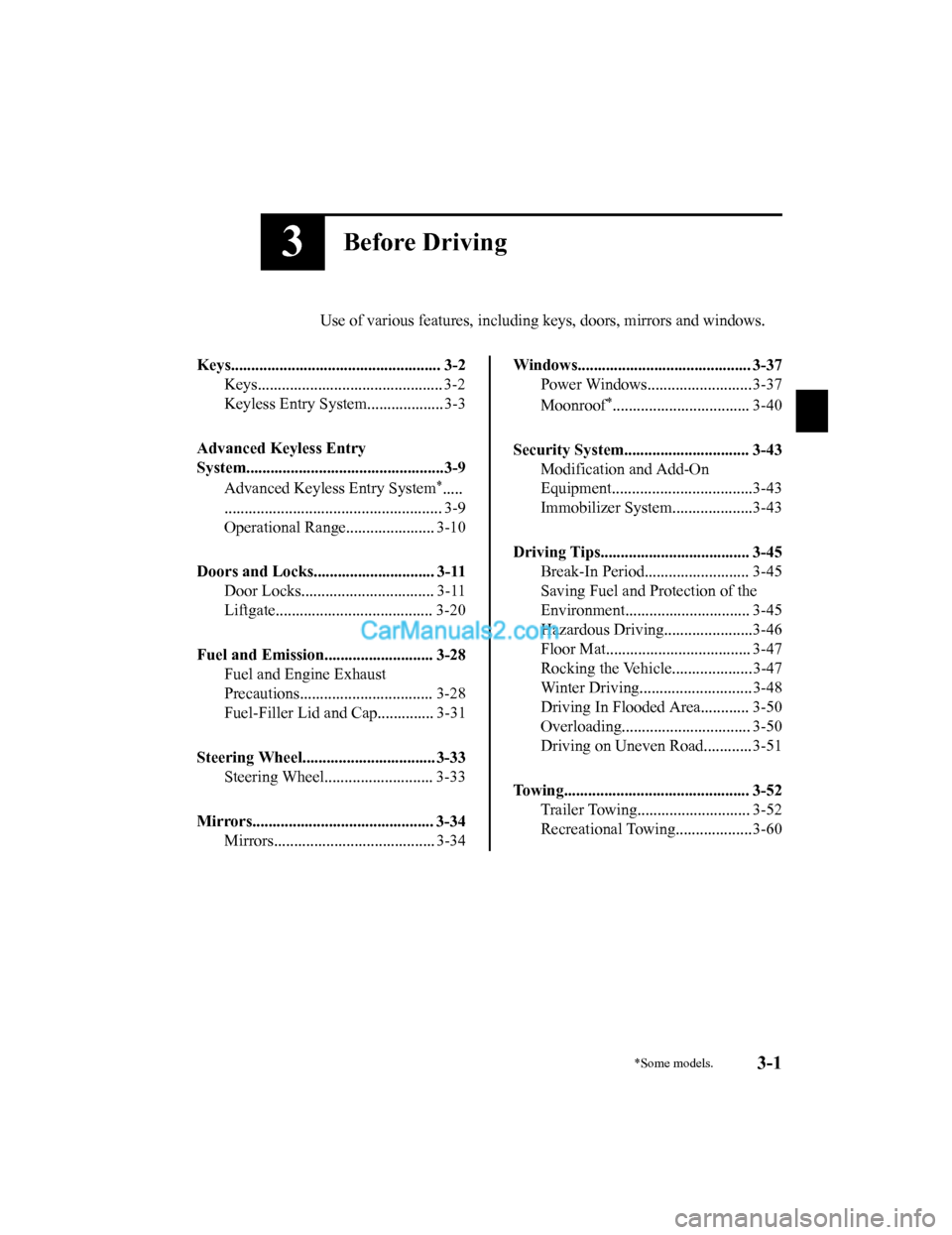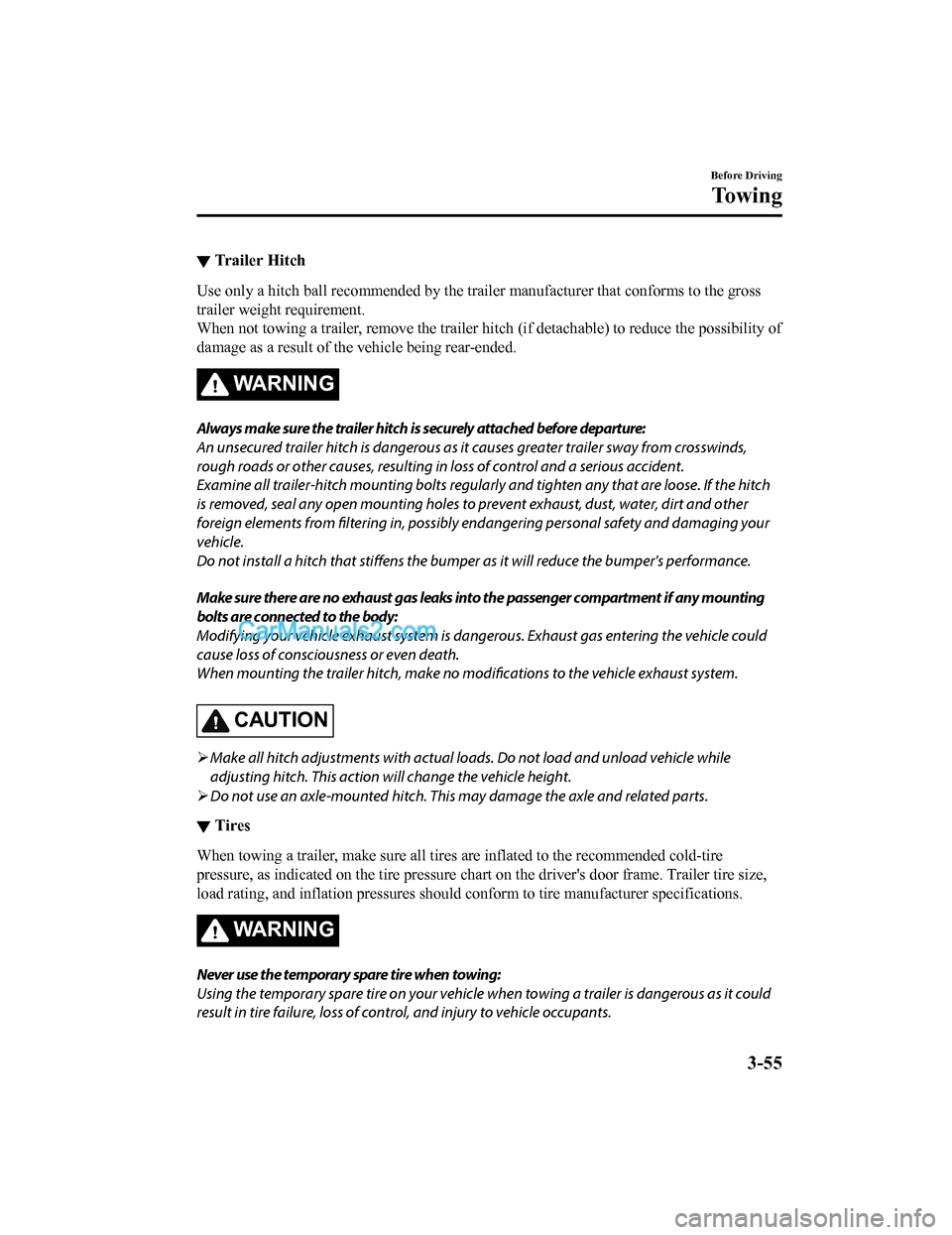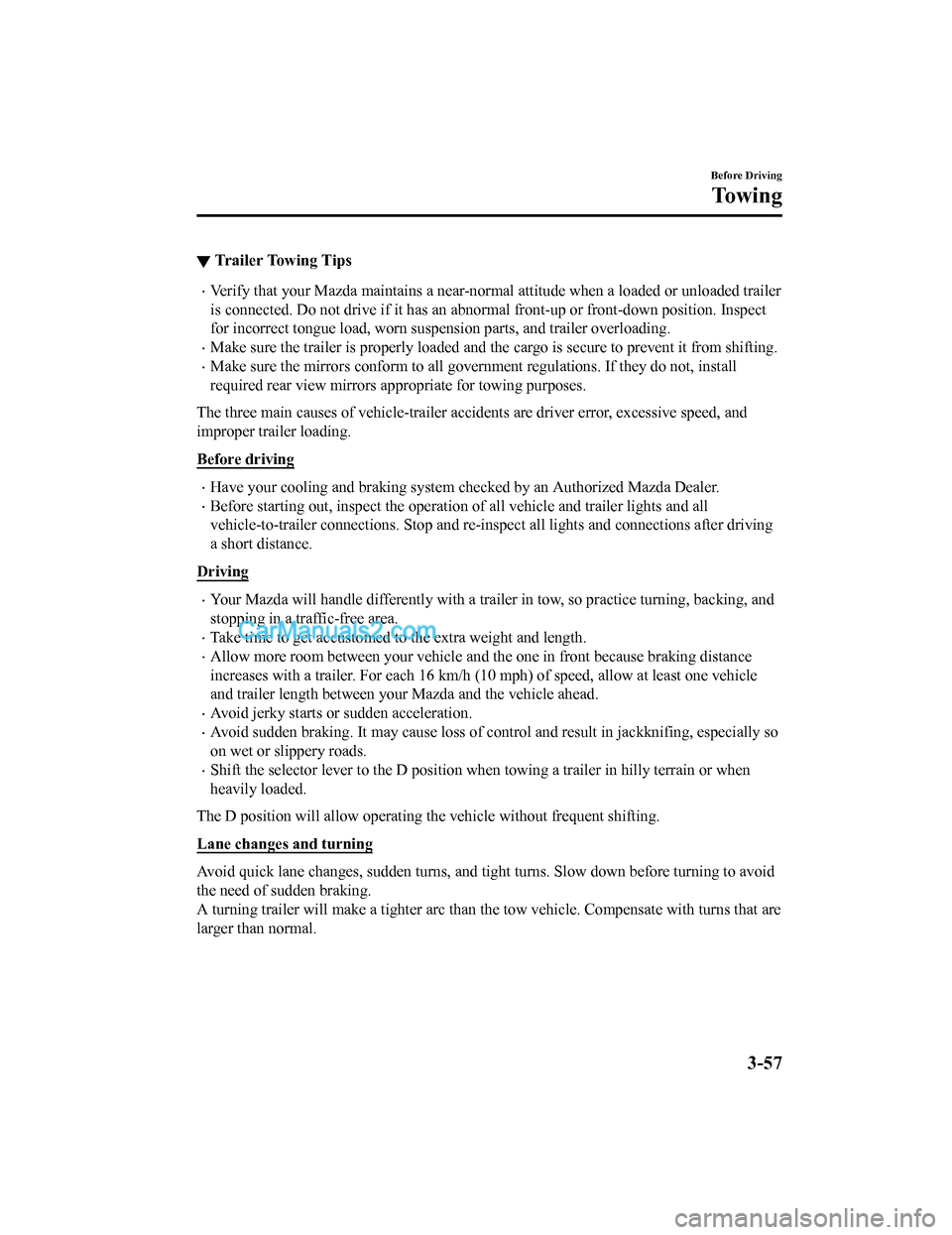tow MAZDA MODEL CX-5 2018 Owners Manual (in English)
[x] Cancel search | Manufacturer: MAZDA, Model Year: 2018, Model line: MODEL CX-5, Model: MAZDA MODEL CX-5 2018Pages: 628, PDF Size: 82.38 MB
Page 40 of 628

Child-Restraint Precautions
Mazda strongly urges the use of child-restraint systems for children small enough to use
them.
You are required by law to use a child-restraint system for children in the U.S. and Canada.
Check your local and state or provincial laws for specific requ irements regarding the safety
of children riding in your vehicle.
Whatever child-restraint system y ou consider, please pick the appropriate one for the age
and size of the child, obey the law and follow the instructions that come with the individual
child-restraint system.
A child who has outgrown child-r estraint systems should sit in the rear and use seat belts,
both lap and shoulder. If the shoulder belt crosses the neck or face, move the child closer to
the center of the vehicle in the outboard seats, and towards the buckle on the right if the
child is seated on the center seat.
Statistics confirm that the rear seat is the best place for all children up to 12 years of age,
and more so with a supplemental restraint system (air bags).
A rear-facing child-restraint system should NEVER be used on the front seat with the air
bag system activated. The front passenger's seat is also the le ast preferred seat for other
child-restraint systems.
To reduce the chance of injuries caused by deployment of the fr ont passenger air bag, the
front passenger occupant classification sensor works as a part of the supplemental restraint
system. This system deactivates the front passenger front and side air bags and also the front
passenger seat belt pretensioner system when the front passenge r air bag deactivation
indicator light illuminates.
When an infant or small child sits on the front passenger seat, the system shuts off the front
passenger front and side air bags and seat belt pretensioner sy stem, so make sure the front
passenger air bag deactivation indicator light illuminates.
Even if the front passenger air bag is shut off, Mazda strongly recommends that children be
properly restrained and child-rest raint systems of all kinds are properly secured on the rear
seats which are the best place for children.
For more details, refer to "Front passenger occupant classification sensor" (page 2-58).
Essential Safety Equipment
Child Restraint
2-26
CX-5_8GN5-EA-17J_Edition1 2017-8-18 12:58:27
Page 77 of 628

3Before Driving
Use of various features, including keys, doors, mirrors and windows.
Keys.................................................... 3-2 Keys.............................................. 3-2
Keyless Entry System................... 3-3
Advanced Keyless Entry
System.................................................3-9 Advanced Keyless Entry System
*.....
...................................................... 3-9
Operational Range...................... 3-10
Doors and Locks.............................. 3-11 Door Locks................................. 3-11
Liftgate....................................... 3-20
Fuel and Emission........................... 3-28 Fuel and Engine Exhaust
Precautions................................. 3-28
Fuel-Filler Lid and Cap.............. 3-31
Steering Wheel................................. 3-33 Steering Wheel....... .................... 3-33
Mirrors............................................. 3-34 Mirrors........................................ 3-34
Windows........................................... 3-37Power Windows..........................3-37
Moonroof
*.................................. 3-40
Security System............................... 3-43 Modification and Add-On
Equipment...................................3-43
Immobilizer System....................3-43
Driving Tips..................................... 3-45 Break-In Period.......................... 3-45
Saving Fuel and Protection of the
Environment............................... 3-45
Hazardous Driving.... ..................3-46
Floor Mat.................................... 3-47
Rocking the Vehicle....................3-47
Winter Driving............................3-48
Driving In Flooded A rea............ 3-50
Overloading................................ 3-50
Driving on Uneven Road............ 3-51
Towing.............................................. 3-52 Trailer Towing............................ 3-52
Recreational Towing................... 3-60
*Some models.3-1
CX-5_8GN5-EA-17J_Edition1 2017-8-18 12:58:27
Page 94 of 628

▼Locking, Unlocking with Auxiliary
Key
Turn the auxiliary key toward the front to
lock, toward the
back to unlock.
To l o c k
All doors and the liftgate lock
automatically when th e driver's door is
locked using the auxiliary key.
To u n l o c k
The driver’s door unlocks when the
auxiliary key is turned briefly to the
unlock position and then immediately
returned to the center position.
All doors and the liftgate unlock when the
driver's door is unlocked and the auxiliary
key is held in the unlock position for one
second or longer.
Lock Unlock
▼
Locking, Unlocking with Door-Lock
Knob
Operation from inside
To lock any door from the inside, press the
door-lock knob.
To unlock, pull it outward.
This does not operate the other door locks.
Lock
Unlock
Unlocked: Red indicator
Before Driving
Doors and Locks
3-18
CX-5_8GN5-EA-17J_Edition1
2017-8-18 12:58:27
Page 121 of 628

Break-In Period
No special break-in is necessary, but a few
precautions in the first 1,000 km (600
miles) may add to the performance,
economy, and life of the vehicle.
•Do not race the engine.
•Do not maintain one constant speed,
either slow or fast, for a long period of
time.
•Do not drive constantly at full-throttle or
high engine rpm for extended periods of
time.
•Avoid unnecessary hard stops.
•Avoid full-throttle starts.
•Do not tow a trailer.
Saving Fuel and Protection of the Environment
How you operate your Mazda determines
how far it will travel on a tank of fuel. Use
these suggestions to help save fuel and
reduce CO
2.
•Avoid long warm-ups. Once the engine
runs smoothly, begin driving.
•Avoid fast starts.
•Drive at lower speeds.
•Anticipate when to apply the brakes
(avoid sudden braking).
•Follow the maintenance schedule (page
6-4) and have an Authorized Mazda
Dealer perform inspections and
servicing.
•Use the air conditioner only when
necessary.
•Slow down on rough roads.
•Keep the tires properly inflated.
•Do not carry unnecessary weight.
•Do not rest your foot on the brake pedal
while driving.
•Keep the wheels in correct alignment.
•Keep windows closed at high speeds.
•Slow down when driving in crosswinds
and headwinds.
WA R N I N G
Never stop the engine when going down a
hill:
Stopping the engine when going down a
hill is dangerous. This causes the loss of
power steering and power brake control,
and may cause damage to the drivetrain.
Any loss of steering or braking control
could cause an accident.
Before Driving
Driving Tips
3-45
CX-5_8GN5-EA-17J_Edition1 2017-8-18 12:58:27
Page 128 of 628

Trailer Towing
Your Mazda was designed and built primarily to carry passengers and cargo.
If you tow a trailer, follow these instructions because driver and passenger safety depends
on proper equipment and safe driving habits. Towing a trailer w ill affect handling, braking,
durability, performance , and fuel economy.
Never overload your vehicle or trailer. Consult an Authorized M azda Dealer if you need
further details.
CAUTION
Do not tow a trailer during the first 1,000 km (6 00 miles) of your new Mazda. If you do, you
may damage the engine, transaxle, differenti al, wheel bearings, and other power-train
components.
▼ Weight Limits
TTW and GCWR
The total trailer weight (TTW),
gross combination weight rating (GCWR), gross axle
weight rating (GAWR), trailer l oad, and trailer tongue load mus t be within the
prescribed limits.
•The total trailer weight (TTW) i s the sum of the weights of the trailer load (trailer
weight plus cargo), trailer hitc h, 2 passengers, and vehicle load (baggage, food, camp
gear, etc.). Never allow the total trailer weight (TTW) to exceed specifications in the
Trailer Towing-Load Table.
•The maximum GCWR is the combinat ion weight of the trailer and load plus the
towing vehicle (includ ing trailer hitch, vehicle passengers, and load). It must not
exceed the specifications in the load table.
GAWR and GVWR
Do not exceed front and rear GAWR (gross axle weight rating) an d GVWR (gross vehicle
weight rating). If you do, vehicle handling, braking, and perfo rmance will be affected. These
values are also on the Motor Vehi cle Safety Certification Label posted on the driver's door
frame.
Before Driving
To w i n g
3-52
CX-5_8GN5-EA-17J_Edition1 2017-8-18 12:58:27
Page 129 of 628

High-altitude operation
CAUTION
Be aware of the towing load weight differences when towing at high altitudes. For altitudes
exceeding 1,000 meter (3,280 ft 10 in), always reduce the towing load by 10 % for every 1,000
meter (3,280 ft 10 in) increase in altitude from the load indicated under the maximum GCWR
heading in the trailer towing-load table. If the determined maximum total towing load
weight is exceeded, the engine and ot her power-train parts may be damaged.
TRAILER TOWING-LOAD TABLE
Because vehicle weights vary, adjustments must be made to meet the requirements in this
table.
Item Model
2WD AWD
MAX. FRON-
TA L A R E A
2.97 m2 (32 ft2)
MAX. TTW
907.2 kg (2,000 lb)
MAX.
GCWR
2,725 kg (6,007.5 lb) 2,784 kg (6,137.6 lb)
MAX. GAWR
Front 1,069 kg (2,357 lb) 1,089 kg (2,401 lb)
Rear 992 kg (2,187 lb) 1,029 kg (2,269 lb)
MAX.
GVWR
2,061 kg (4,544 lb) 2,118 kg (4,669 lb)
TRAIL-
ER-TONGUE
LOAD Tongue load
Tongue load/Trailer load × 100 = 10 % to 15 %
Trailer load
DISTRIBU-
TION OF
TRAILER
LOADFront 60 %
Rear 40 %
Before Driving
To w i n g
3-53
CX-5_8GN5-EA-17J_Edition1 2017-8-18 12:58:27
Page 130 of 628

WA R N I N G
Always keep tow loads within specified limits as indicated in the Trailer Towing-Load Table:
Attempting to tow loads greater than those sp ecified is dangerous as it may cause serious
handling and performance problems that could res ult in personal injury or vehicle damage,
or both.
Load your trailer with the weight about 60 % toward the front and 40 % toward the rear:
Loading the trailer with more weight in the rear than in the front is dangerous. Doing so could
cause you to lose control. The tr ailer tongue load must be 10 %―15 % of the total trailer load
(sum of the weights of the trailer and cargo).
Always have the total trailer weight and tongue load determined prior to departure:
Attempting to tow loads without determining the total trailer weight and tongue load is
dangerous. Trailer sway from crosswinds, rough roads or other causes could result in loss of
control and a serious accident.
CAUTION
The total trailer weight and tongue load ca n be determined by weighing the trailer on
platform scales at a highway weight station or a trucking company.
Before Driving
To w i n g
3-54
CX-5_8GN5-EA-17J_Edition1 2017-8-18 12:58:27
Page 131 of 628

▼Trailer Hitch
Use only a hitch ball recommended by the trailer manufacturer that conforms to the gross
trailer weight requirement.
When not towing a trailer, remove
the trailer hitch (if detachable) to reduce the possibility of
damage as a result of the vehicle being rear-ended.
WA R N I N G
Always make sure the trailer hitch is securely attached before departure:
An unsecured trailer hitch is dangerous as it causes greater trailer sway from crosswinds,
rough roads or other causes, resulting in loss of control and a serious accident.
Examine all trailer-hitch mounting bolts regularly and tighten any that are loose. If the hitch
is removed, seal any open mounting holes to prevent exhaust, dust, water, dirt and other
foreign elements from filtering in, possibly en dangering personal safety and damaging your
vehicle.
Do not install a hitch that stiffens the bumper as it will reduce the bumper's performance.
Make sure there are no exhaust gas leaks into the passenger compartment if any mounting
bolts are connected to the body:
Modifying your vehicle exhaust system is dangerous. Exhaust gas entering the vehicle could
cause loss of consciousness or even death.
When mounting the trailer hitch, make no modifications to the vehicle exhaust system.
CAUTION
Make all hitch adjustments with actual load s. Do not load and unload vehicle while
adjusting hitch. This action w ill change the vehicle height.
Do not use an axle-mounted hitch. This may damage the axle and related parts.
▼Tires
When towing a trailer, make sure all tires are inflated to the
recommended cold-tire
pressure, as indicated on the tire pressure chart on the driver 's door frame. Trailer tire size,
load rating, and inflation pressu res should conform to tire manufacturer specifications.
WA R N I N G
Never use the temporary spare tire when towing:
Using the temporary spare tire on your vehicle wh en towing a trailer is dangerous as it could
result in tire failure, loss of control, and injury to vehicle occupants.
Before Driving
To w i n g
3-55
CX-5_8GN5-EA-17J_Edition1 2017-8-18 12:58:27
Page 132 of 628

▼Safety Chains
Safety chains must be used as a precautionary measure should th
e trailer become
unintentionally unhitched. They should cross under the trailer tongue and attach to the hitch.
Leave enough slack to allow full turns. Consult literature publ ished by your trailer or hitch
manufacturer for more details.
WA R N I N G
Make sure the safety chain is securely attached to both the trailer and the vehicle prior to
departure:
Towing a trailer without using a safety chain securely attached to both the trailer and the
vehicle is dangerous. If damage occurs to the coupling unit or hitch ball, the trailer could
wander into another lane and cause a collision.
▼ Trailer Lights
Trailer lights must comply with
all federal, state, and local regulations. Equip your trailer as
required before towing it day or night.
CAUTION
Do not connect a trailer lighting system directl y to the lighting system of your Mazda. This
may damage your vehicle's electrical system an d lighting systems. Have a recreational vehicle
dealer or trailer rental agency connect the system, and inspect the brake lights and turn
signals yourself before each trip.
▼ Trailer Brakes
If the total trailer weight ex
ceeds 450 kg (1,000 lb), trailer brakes are required. If your trailer
has brakes, make sure they comply with all federal, state, and local regulations.
WA R N I N G
Do not connect a hydraulic trailer-brake system to your vehicle's brake system:
Connecting a hydraulic trailer-brake system directly to the vehicle brake system is dangerous
and will result in inadequate braking and possible injury.
Before Driving
To w i n g
3-56
CX-5_8GN5-EA-17J_Edition1 2017-8-18 12:58:27
Page 133 of 628

▼Trailer Towing Tips
•Verify that your Mazda
maintains a near-normal attitude when a loaded or unloaded trailer
is connected. Do not drive if it has an abn ormal front-up or front-down position. Inspect
for incorrect tongue load, worn suspension parts, and trailer o verloading.
•Make sure the trailer is properly loaded and the cargo is secur e to prevent it from shifting.
•Make sure the mirrors conform to all government regulations. If they do not, install
required rear view mirrors appr opriate for towing purposes.
The three main causes of vehicle-trailer accidents are driver e rror, excessive speed, and
improper trailer loading.
Before driving
•Have your cooling and braking system checked by an Authorized M azda Dealer.
•Before starting out, inspect the operation of all vehicle and trailer lights and all
vehicle-to-trailer connections. S top and re-inspect all lights and connections after driving
a short distance.
Driving
•Your Mazda will handle differe ntly with a trailer in tow, so practice turning, backing, and
stopping in a traffic-free area.
•Take time to get accustomed to the extra weight and length.
•Allow more room between your vehicle and the one in front becau se braking distance
increases with a trailer. For eac h 16 km/h (10 mph) of speed, a llow at least one vehicle
and trailer length between your Mazda and the vehicle ahead.
•Avoid jerky starts or sudden acceleration.
•Avoid sudden braking. It may cau se loss of control and result in jackknifing, especially so
on wet or slippery roads.
•Shift the selector lever to the D position when towing a traile r in hilly terrain or when
heavily loaded.
The D position will allow opera ting the vehicle without frequen t shifting.
Lane changes and turning
Avoid quick lane changes, sudden turns, and tight turns. Slow d own before turning to avoid
the need of sudden braking.
A turning trailer will make a tigh ter arc than the tow vehicle. Compensate with turns that are
larger than normal.
Before Driving
To w i n g
3-57
CX-5_8GN5-EA-17J_Edition1 2017-8-18 12:58:27